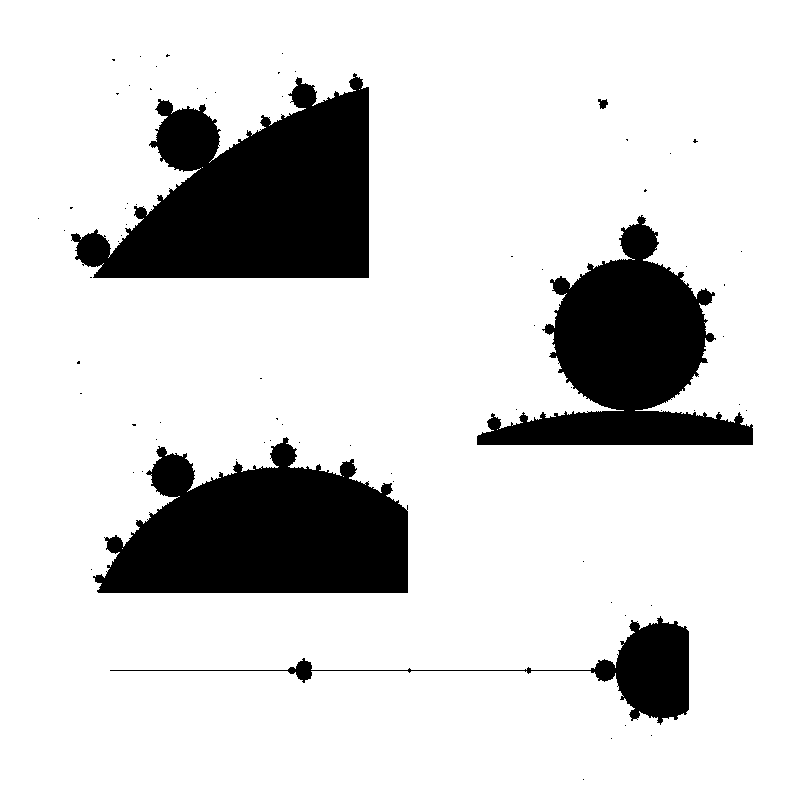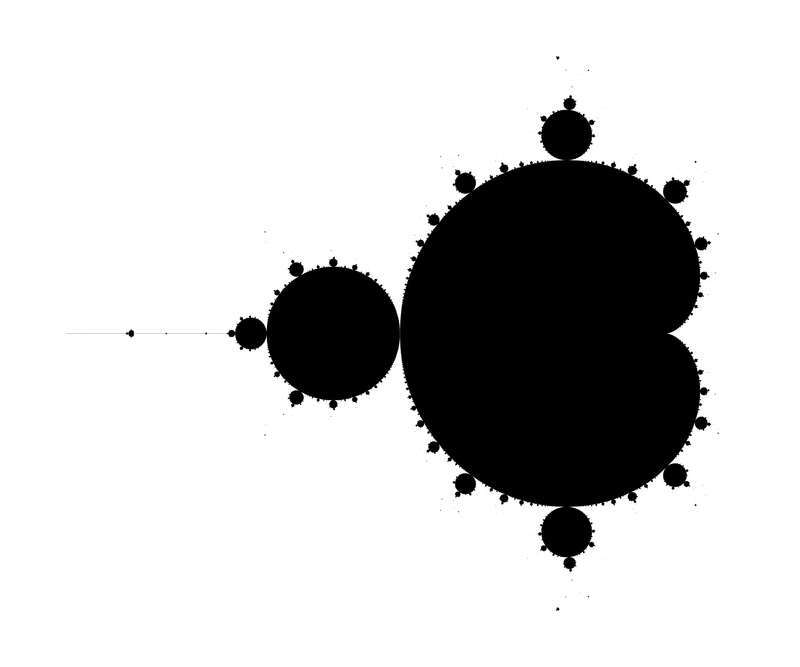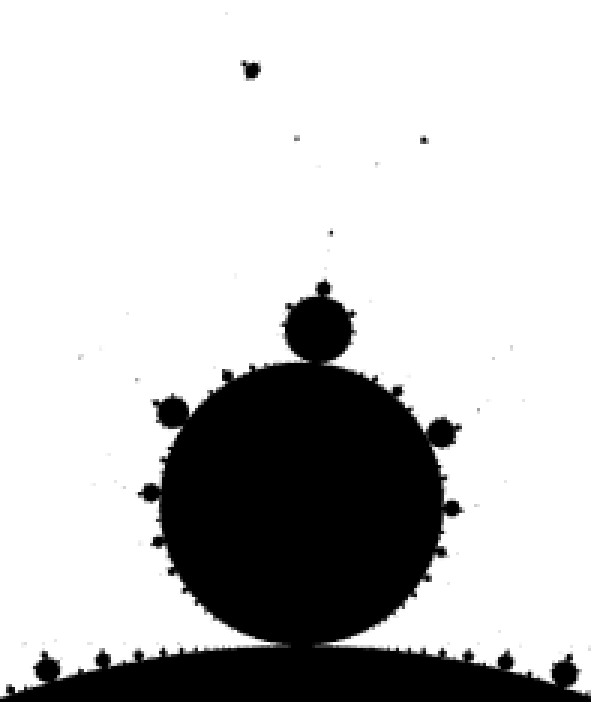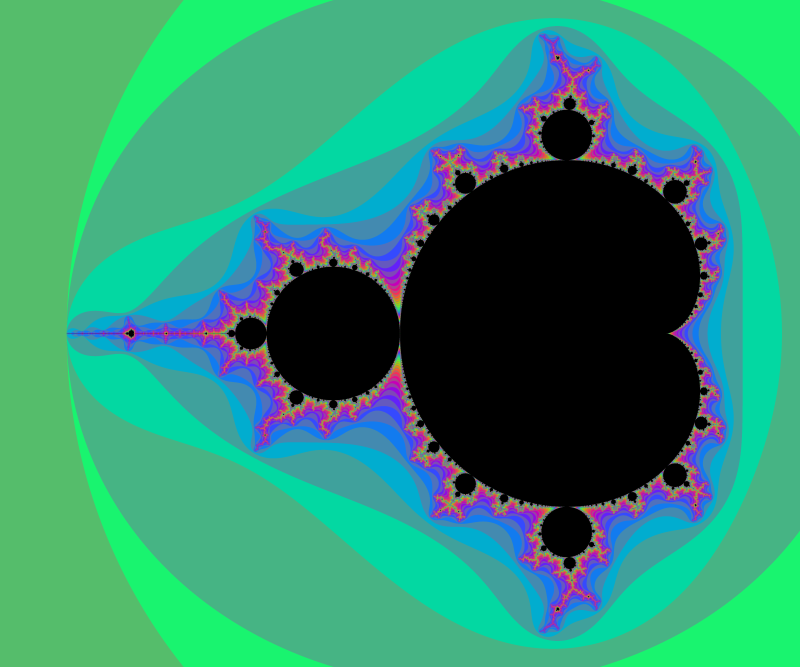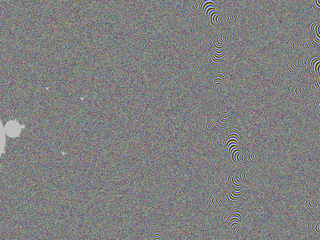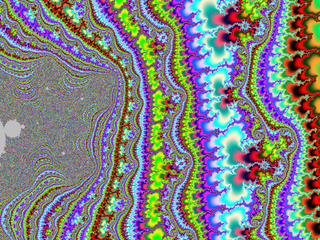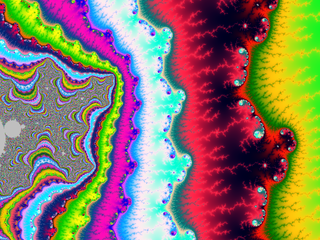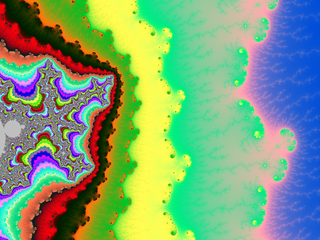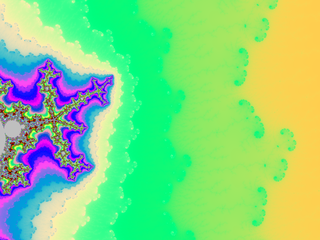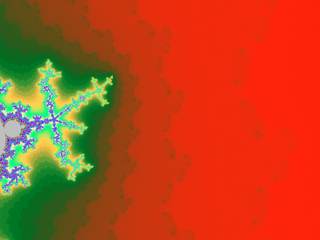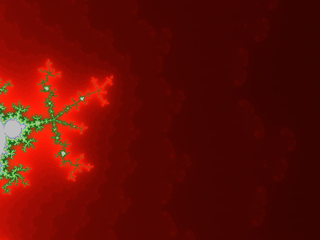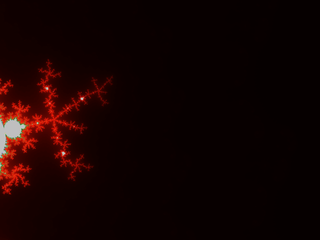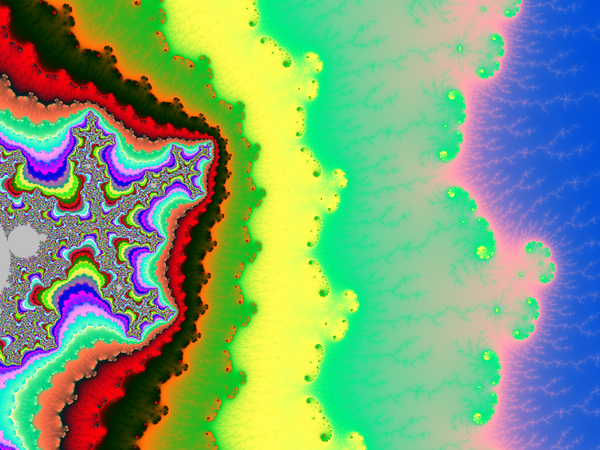Difference between revisions of "Mandelbrot set"
(→Interior detection methods) |
(→The idea) |
||
| Line 306: | Line 306: | ||
z = c | z = c | ||
der = 1+0j | der = 1+0j | ||
| − | color = | + | color = not_enough_iterates_color # replace it by inside_color if you prefer |
for n in range(0,N): | for n in range(0,N): | ||
| − | if squared_modulus(der)< | + | if squared_modulus(der) < eps*eps: # eps is the threshold, a small number |
| − | color = | + | color = inside_color |
| − | break: # here, this jumps to the last line | + | break: # here, this jumps to the last line |
| − | if squared_modulus(z)>R*R: # put here your preferred R>2 | + | if squared_modulus(z) > R*R: # put here your preferred R>=2 |
| − | color = | + | color = outside_color # replace here by your preferred color scheme outside M |
| − | break: # here, this jumps to the last line | + | break: # here, this jumps to the last line |
| − | der = der * 2 # order matters | + | der = der*2*z # order matters: do not modify z --before-- computing the new der |
| − | z = z*z+c | + | z = z*z+c # order matters |
p.color=color # last line | p.color=color # last line | ||
</syntaxhighlight> | </syntaxhighlight> | ||
Revision as of 15:52, 21 December 2015
Here we will give a few algorithms and show the corresponding results.
Contents
The Mandelbrot set
Certainly, Wikipedia's page about this set in any language should be a very good introduction to this set. Here I give a very quick definition/reminder:
The Mandelbrot set, denoted M, is the set of complex numbers $c$ such that the critical point $z=0$ of the polynomial $P(z)=z^2+c$ has an orbit that is not attracted to infinity. If you do not know any of the italicized words, go and look on the Internet.
It is significant for two reasons:
- The Julia set of $P$ is connected if and only if $c\in M$.
- The dynamical system $z\mapsto P(z)$ is stable under a perturbation of $P$ if and only if $c\in \partial M$, where $\partial $ is a notation for the topological boundary.
Drawing algorithms
All the algorithms I will present here are scanline methods.
Basic algorithm
The most basic is the following, it is based on the following theorem:
Theorem: The orbit of 0 tends to infinity if and only if at some point it has modulus >2.
This theorem is specific to $z\mapsto z^2+c$, but can be adapted to other families of polynomials by changing the threshold $2$ to another one. Here the threshold does not depend $c$ but in other families it may.
Now here is the algorithm:
Choose a maximal iteration number N
For each pixel p of the image:
Let c be the complex number represented by p
Let z be a complex variable
Set z to 0
Do the following N times:
If |z|>2 then color the pixel white, end this loop prematurely, go to the next pixel
Otherwise replace z by z*z+c
When the loop above reached its natural end: color the pixel p in black
Go to the next pixel
I am not going to use the syntax above again, since it is too detailed. Let us see what it gives in a Python-like style:
for p in allpixels: # replace here by your own loop or pair of loops to scan all pixels
c = p.affix # here you may replace by your code computing c (complex nb)
z = 0j
color = black # this color will be assigned to p at the end, black is a temporary value
for n in range(0,N):
if squared_modulus(z)>4:
color = white
break: # this will break the innermost for loop and jump just after (two lines below)
z = z*z+c
p.color = color # so it will be white unless we ran into the line color=black
Here in a C++ like style: (std::complex<double> simplified into complex)
for(int i=0; i<height; i++) {
for(int j=0; j<width; j++) {
complex c = some formula of i and j;
complex z = 0.;
for(int n=0; n<N; n++) {
if(squared_modulus(z)>4) {
image[i][j]=black;
goto label;
}
z = z*z+c;
}
image[i][j]=white;
label: {}
}
}
Let us now look at the kind of pictures we get with that. We took an image size of 241×201 pixels, with a mathematical width of 3.0 and so that the center pixel has affix -0.75. The only varying parameter between them is the maximal number of iterations N.
All images except the last one took a fraction of a second to compute on a modern laptop. Back then in the 1980's it was different.
Ideally the maximal number of iterations N should be infinity, but then the computation would never stop. The idea is then that the bigger N is, the more accurate the picture should be.
The N=one million image took 45s to compute on the same laptop, which is pretty long given today's computers power. What happens? Every black pixel requires $10^6$ iterations, and since there are 9 771 of them, we do at least ~$10^{10}$ times the computation z*z+c. To accelerate this, one should find a way to detect that we are in M so that we use less than the maximal number of iterations.
But that is not the only problem with increasing N. Not only it took much time, but the difference with N=100 is pretty small. Worse: it seems that by increasing N we are losing parts of the picture. What happens is that we are testing pixel centers or corners, and there are strands of M that are thin and wiggle between the pixel centers, so that as soon as N is big enough, the pixel gets colored white.
Here are enlarged versions of parts of these images, so that pixels are visible.
Let us look at a parts of a higher resolution image, computed with a big value of N: notice the small islands. The set M is connected in fact, but the strands connecting the different black parts are invisible, except some horizontal line that appears because, by coincidence, we are testing there complex numbers that belong to the real line: $M\cap \mathbb{R} = [-2,0.25]$.
The next image has been computed using a 4801×4001px image and then downscaling by a factor of 6 (in both directions) to get an antialiased grayscale image. It also has been cropped down a little bit, to fit in this column without further rescaling.
Last, an enlargment to see the pixels of the above image:
Escape time based coloring
There is a simple and surprisingly efficient modification of the above algorithm.
We started from z=0 and iterated the substitution $z\mapsto z^2+c$ until either |z|>2 (the orbit escapes) or the number of iterations became too big. Instead of coloring white the pixels for which the orbit escapes, we assign a color that depends on n, the first iteration number for which |z|>2.
def f(n): # this function returns a color depending on an integer n
return ... # put here your custom code
for p in allpixels:
c = p.affix
z = 0j
color = black
for n in range(0,N):
if squared_modulus(z)>4:
color = f(n)
break:
z = z*z+c
p.color = color
For the coloring, you are free to take your preferred function of n, I will not develop on that here.
Here is an example of result:
The strands became visible again.
Here is another one, on a 4801×4001px grid, downscaled by a factor 5, with N=10000 (which is probably a bit excessive in this particular case).
With a nicely chosen color function, one can get pretty results:
The following was popular in printed books:
The potential
You may replace the test |z|>2 by |z|>R, provided that R>2. In fact the picture looks better that way. It has an explanation in terms of the potential.
- Physics digression: In very informal terms, in a 2D euclidean universe, put an electrostatic charge on some conducting bounded connected set K, the rest of 2D space being void (dielectric). You will put charge=-1 and assume there are so many particles (electrons) that the charge can be considered as a continuum. Then let the charges spontaneously move to minimize the energy. The resulting distribution has the property that the potential is constant on K. The potential function $V$ satisfies the Laplace equation $\Delta V=0$ outside K and $V(c)\sim \rho \log|c| $ when $|c|\longrightarrow+\infty$, for some constant $\rho$.
There is however no need to invoke electrostatics and one can define directly the following function and decide to call it the potential: $$V(c)=\lim_{n\to+\infty} \frac{\log_+|P_c^n(0)|}{2^n}$$ where $\log_+(x)$ is defined as $0$ if $x<1$ and $\log(x)$ otherwise. The exponent n in $P_c^n$ refers to composition, not exponentiation: $P^n(z)$ is P applied n times to z. The function V takes value 0 exactly on M. If x>0, the sets of equation V=x are called equipotentials of M. They foliate the outside of M into smooth simple closed curves that encircle it. The potential also finds an importance in the mathematical study of M, as holomorphic functions are involved, but that is not a the topic to be discussed here.
The fact that the formula converges and that its limit has the stated properties is not supposed to be obvious: it is a theorem too. One good thing about the formula is that it converges quite well: if we stop the iteration when |z|>R, the relative error will be of order 1/R. Now assume the picture is drawn for $|c|<10$ (anyway all points of M satisfy $|c|\leq 2$) and at some point in the iteration of $0$ we reach $|z|>4$. Then a value of $|z|>1000$ is reached pretty fast because $|P(z)|=|z^2+c|>|z|^2-5$: one sees that in 4 more iterations we have at least |z|>443556...
In the computation, when |z|=R after n iteration, and R is big enough, it means $V(c)\approx\log(R)/2^n$. Hence taking R=1000 in the previous algorithm (see the picture above) yields color regions whose boundaries very closely match the equipotentials $V(c)=\log(1000)/2^n$. This is what the picture above shows.
But we can do better: as soon as $|z|>1000$, we have a good approximation $V(c)\approx\log|z|/2^n$, and we can thus choose a continuous coloring scheme depending on $V(c)$.
Here is a possible algorithm:
def f(V): # this function returns a color depending on a float V
return ... # put here your custom code
for p in allpixels:
c = p.affix
z = 0j
color = inside_color # color may be modified below and assigned to p
pow = 1. # pow will hold 2^n
for n in range(0,N):
R2 = squared_modulus(z)
if R2>1000000: # 1000 squared
V = log(R2)/pow
color = f(V)
break: # this will break the innermost for loop and jump just after
z = z*z+c
pow = pow * 2.
p.color = color
And here an example of result: computed with N=2000 and 4800×4000px and a color function that starts black away from M, then slighlty oscillate in shades of blue like a sine function of log(V), but when V gets small a uniform egg yellow components takes over, and even closer it is a black one. The set M is in dark bordeaux red.
Deep zooms and log-potential scale
The function $V$ is continuous and has value $0$ exactly on M.
The function $\log V$ is better suited than $V$ for coloring deep zooms. For instance in many points (especially tips and branch points which are asymptotically self-similar [Tan Lei]) a zoom will essentially shift the value of $\log V$ by a adding a constant that depends on the situation.
A simple choice is to have a color that cycles when some chosen constant is added to $\log V$. This choice is also a heritage from when images had a limited palette. So choose $K>0$ and set $$x=\log(V)/K$$ $$\mathrm{color}=g(x)$$ for some function g with g(x+1)=g(x). You can enforce periodicity by reducing x modulo 1 to [0,1[ but that may introduce discontinuities if g was not 1-periodic. For instance $$g(x)=(R,G,B)=(255,255,255)\times\frac{1+\cos(2\pi x)}{2}$$ will yield a smooth wave pattern, from white to black and back.
Taking $K= \log 2$ is a good starting choice, as it is "natural" for reasons we will explain later. You may already notice that $\log \log P(z) \approx (\log\log |z|) + \log 2$ when z is big. However, M gets quite furry in some deep zooms, it is then better to divide by a bigger constant in this case.
Below, some illustrations: Instead of a periodic function we chose a quasiperiodic one: $$g(x)=(R,G,B)=\left(255\times\frac{1-\cos(a x)}{2},255\times\frac{1-\cos(b x)}{2},255\times\frac{1-\cos(c x)}{2}\right)$$ with $(a,b,c)=\left(1,\frac{1}{3\sqrt2},\frac{1}{7\cdot3^{1/8}}\right)\times\frac{1}{\log 2}$ linearly independent over $\mathbb{Z}$. (It is not the prettiest choice; this is not the point, though.)
Below, 12 views of the same deep zoom on M. Only K varies, taking respective values 0.03, 0.1, 0.3, 1, 3, 10, 30, 100, 300, 1000, 3000 and 10000. They are all downscaled by a factor 2 from an original of 2400×1800px. They is a further rescaling in the thumbnails below, but you can click on them to get the 1200×900px version.
It is particularly visible on the 7th one, that not one value of K can capture all the filamental structure : on the right it is barely visible, and on the left near the circular gray shapes it is a mess.
Note: the computation of the images above have been accelerated using the interior detection method described later in this page.
Interior detection methods
Math digression: hyperbolic components
We must now introduce hyperbolic components. If you take c inside M, there is a good chance that c will belong to one.
Definitions:
- A periodic point for P is a point $a$ such that $P^k(a)=a$ for some k>0.
- The first $k>0$ for which this occurs is called the period of a.
- The orbit of $a$ is then finite: it is called a cycle.
- The value of $(P^k)'$ is the same at any point in the orbit of a: it is called the multiplier of the cycle.
- A cycle is called attracting or attractive or a sink if the multiplier has modulus<1.
- A parameter c is called hyperbolic if $P_c$ has an attracting cycle.
Recall that $P_c$ is defined by $P_c(z)=z^2+c$. For hyperbolic parameters, Fatou proved* that the critical point is attracted to this cycle. In particular, $c\in M$.
(*) This is a quite striking feature of non-locality holomorphic dynamics: the cycle has an attracting power that reaches to the critical point.
Fatou also prove that $P_c$ can have at most one attracting cycle.
Why call this "hyperbolic"? In more general dynamical systems, this word has another definition, which in our case would read as follows: $P_c$ is expanding on its Julia set. It turns out that the two definitions are equivalent, a highly non-trivial fact.
Hyperbolic parameters are stable: all nearby parameters are also hyperbolic, the attracting cycle and the Julia set move continuously when $c$ varies in a small neighborhood. The hyperbolic component associated to $c$ is the connected component of the set of hyperbolic parameters that contains c. Such a component is bounded by an algebraic curve, smooth except at at most one point. This curve is composed of those parameters for which the multiplier of the cycle has modulus one. In fact for this family $P_c$, the components are either like disks or like interior of cardioids. They have no holes.
It can be proved that these boundary curves are contained in the topological boundary of M: hence a hyperbolic component is also a connected component of the interior of M. We do not know if the converse holds: this is Fatou's conjecture, still open today:
Conjecture: All connected components of the interior of M are hyperbolic.
It is a big conjecture. Solve it and become famous.
Following the derivative
As we iterate z, we can look at the derivatives of P at z. In our case it is quite simple: $P'(z)=2z$. Multiplying all these numbers along an orbit yields the derivative at z of the composition $P^n$. This multiplication can be carried on iteratively as we iterate z:
[...]
der = 1
z = c # note that we start with c instead of 0, to avoid multiplying the derivative by 0
for n in range(0,N):
der = der*2*z
z = z*z+c
[...]
If we started from the critical point there is a 0 at the beginning of the product, so $(P^n)'(0)=0$. However, omitting the first term yields $(P^n)'(c)$, which has a good chance to be non-zero: it will be 0 if and only if 0 is periodic, which corresponds to the centers of the hyperbolic components of M, a notion that I will not develop here: you just need to know that they lie in the smooth areas inside M.
The idea
Now if $c$ is a hyperbolic parameter then its orbit tends to an attracting cycle and therefore the derivative above will tend to $0$. The basic idea is then to choose a threshold and stop the computation when the derivative $(P^n)'(c)$ has reached a modulus below this threshold $\epsilon$ and declare the pixel to be in M (in its interior in fact) and color it according to this and your taste.
The algorithm is then to take this as a criterion for interior detection, i.e. to assume that the converse holds (or at worst that the mistake is barely noticeable).
for p in allpixels:
c = p.affix
z = c
der = 1+0j
color = not_enough_iterates_color # replace it by inside_color if you prefer
for n in range(0,N):
if squared_modulus(der) < eps*eps: # eps is the threshold, a small number
color = inside_color
break: # here, this jumps to the last line
if squared_modulus(z) > R*R: # put here your preferred R>=2
color = outside_color # replace here by your preferred color scheme outside M
break: # here, this jumps to the last line
der = der*2*z # order matters: do not modify z --before-- computing the new der
z = z*z+c # order matters
p.color=color # last line
This method was first explained to me by Xavier Buff, who tested it and told me it gives good result, which I never would have thought.
So, does the converse hold? Does getting below $\epsilon$ ensure that there is an attracting periodic cycle ? What would be the danger? The orbit of $c$ could spend too much time in the area where $|P'|<1$, or it may pass a few times too close to $0$. In the second case it seems intuitive that $c$ must be close to the center of a hyperbolic component. But what about the first case?
Images
TO BE COMPLETED








